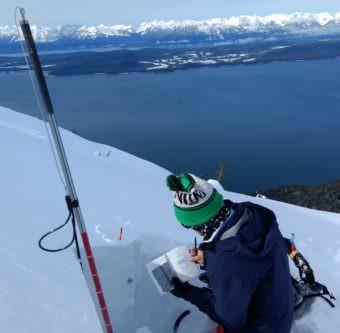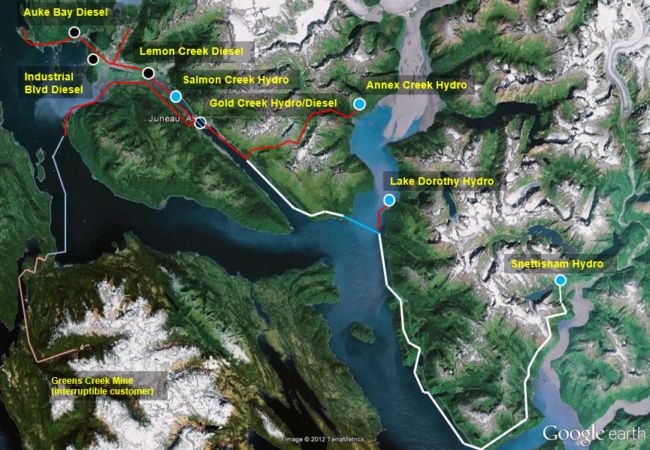Most of Juneau’s power is hydroelectric. Getting that power to the community requires transmission lines that traverse through miles of avalanche country. That’s why Alaska Electric Light and Power Company hires helicopter crews to trigger slides to prevent destructive avalanches from knocking out the power.
A lot of AELP’s power grid is miles from any road. Flying at about 4,000 feet in a chartered AStar helicopter, AELP’s avalanche forecaster Mike Janes gives the lay of the land. He points to high tension power lines that traverse an area across from Taku Inlet southeast of town.
“This is all power coming from Snettisham where we’re headed and the Lake Dorothy project is over there,” Janes said.
Extreme swings in temperature — blame it on climate change – have made the snowpack in the mountains less stable. That’s kept avalanche control crews busy.
In the time that I’ve been doing this we’ve had record snow years at alpine and record low snow years at alpine all within a few years here. If anything it’s making it more extreme and gives us for more possibility for layering to develop.That’s kind of what’s happening this year when it’s dry and clear and cold for awhile and formed a snowpack you might see more commonly in Colorado and now we’re kinda going more to the more maritime, more snowfall, warmer temps regime and those two don’t mix very well together normally.
The bird’s-eye view has its limitations. The helicopter touches down near the summit of 3,300-foot Arthur Peak to drop off avalanche technician Kanaan Bausler. He’s running a simple test on the snowpack.

“Basically we cut out a block in the snow and try to see how the energy that we are putting on the snowpack by tapping on it with our shovel – how that transfers through the block,” Bausler said.
“Sudden collapse! Wow. That’s pretty exciting. That’s worth writing down,” Bausler continued. “This test definitely was a red flag for stability conditions from what we just saw here.”
It’s not long before Mike Janes returns in the helicopter. Dangling about 150 feet below is a device called a Daisybell. Fully loaded, it weighs about 1,000 pounds. The Daisybell creates a concussive blast by blending oxygen and hydrogen, then adding a spark that ignites the mix.
It’s like a man-made thunderclap.
“You can see the flash,” Bausler said. “It creates quite a nice explosion – a pretty good punch for the snowpack.”
Gone are the days of throwing explosives from the air. This is a cheaper — and safer — solution.
Hovering at just a hundred feet Mike Janes and the pilot position the Daisybell just a few feet over snowpack that’s layered into a natural cornice on the cliff’s edge.
There hasn’t been much movement. Then the crew realize they’d triggered something big.
“You can’t see it but we got probably 100-foot wide – it looks like it’s down on that layer,” Janes said. “I don’t know which shot it happened on. But it pulled about 20 feet below one of the shots we already made.”
After 45 minutes of firing the crew’s work is done — for now.
Bausler said modern avalanche control is often more methodic than dramatic.
“Any day that we can come out and trigger some snow off the slope that isn’t just stacking up there and waiting for a bigger slide to come — then we feel pretty good about that,” Bausler said.
Juneau was cut off from hydro power for 45 days in 2008 after a slide knocked out transmission lines. AELP had to burn diesel to keep the lights on. It was as environmentally unfriendly as it was expensive for the company and ratepayers.

After that experience, the utility invested millions into its avalanche control program. With the help of state grants, the company erected barriers to protect its most vulnerable transmission towers.
Avalanche crews will work through spring to keep nearly 60 miles of overhead transmission lines protected from slides. That should keep hydropower flowing to Juneau’s households and businesses during even the snowiest months.
Jacob Resneck is CoastAlaska's regional news director in Juneau.




